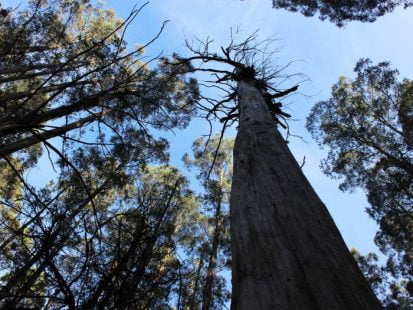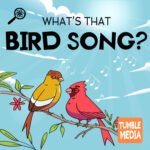
Lyrebird songs in a Gippsland rainforest
Leave a reviewNo music, no voices, just the sound of the forest waking up. I made this recording on a wintery morning, outside a hut high up in the mountains of Gippsland on Gunaikurnai land. I arrived in the dark and didn’t realise how high up the hill I was. As the sun rose it took time for it to reach the bottom of the gullies, and so the dawn chorus extended longer and was more distant and echoey. It’s harder than normal to decipher what’s what in this recording because all around the hut there were lyrebirds singing, and they’re masters of imitation.
© Australian Broadcasting Corporation | 01:35:54
|
Full episode description
 Episode One: Calm, flowing creek with night-time frog calls
Episode One: Calm, flowing creek with night-time frog calls
This is an Episodic show. You can listen to it in any order, but episode one is always a great place to start.Full Episode description
No music, no voices, just the sound of the forest waking up. I made this recording on a wintery morning, outside a hut high up in the mountains of Gippsland on Gunaikurnai land. I arrived in the dark and didn’t realise how high up the hill I was. As the sun rose it took time for it to reach the bottom of the gullies, and so the dawn chorus extended longer and was more distant and echoey. It’s harder than normal to decipher what’s what in this recording because all around the hut there were lyrebirds singing, and they’re masters of imitation.
Listening notes from Ann Jones:
00:00:00 As the sun rises and warms the roof, icy water drips to the ground creating clicks and drips throughout. Immediately, several lyrebird males can be heard rehearsing their songs. This isn’t normally the time of day that they’d be wooing a female directly, it’s more for practice and territorial defence, and also perhaps luring a female towards their dancing mound. They call like this throughout the coldest part of winter.
00:02:06 Rather than an actual whipbird, I think that this is the lyrebird imitating a whip bird!
00:03:00 I think the interminable piping is from a white-throated tree creeper.
00:05:00 It is possibly a striated thornbill group twittering close to the microphone, but certainly one of the ‘LBJ’ class. (That is what birders call ‘Little Brown Jobs’ – birds that are all small and brown and difficult to identify.)
00:08:18 A wattlebird chucks.
00:25:30 These are rosella sounds I think, the chattering that keeps them in contact as they move.
00:30:39 Is it a kookaburra or a lyrebird imitating a kookaburra? I think the latter as it cuts off rather awkwardly – kookaburras often wind down at the end of their calls in a very funny moany-giggle.
00:32:22 Here the lyrebird imitates, briefly, a black cockie within its stream of song. Other calls it imitates include grey shrikethrush, currawongs, magpies and wattlebirds.
01:08:30 Actual yellow-tailed black cockatoos! There’s a story that they travel before rain but I’m not sure if anyone has done the science on that one. These are big cockies, much bigger than a sulphur crested. They have yellow patches under the tale and fly with long wing strokes somewhat like a waterbird. Absolutely majestic and you are obliged to stop and point to them when you see them.
01:13:55 A kangaroo or wallaby thumps past.
01:34:30 A small flock of gang-gang cockatoos fly past, which sound like squeaky doors. About the size of a galah they are mostly black. The males have red heads and instead of a crest like a cockie, they have a little feathery flourish on the top of their head like a centurion’s helmet. The females are mostly black with exquisite red detailing and together they call in this incredibly unique, needs-oiling croak.
© Australian Broadcasting Corporationbop| Status: Active, 17 episodes | Kind: Episodic | Episode URL
The content, Artwork and advertising within this podcast is not owned or affiliated with Sound Carrot and remain the property of their respective owners.









